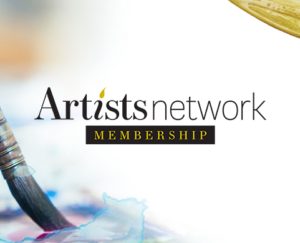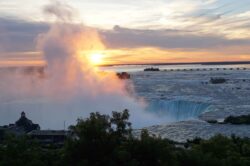Beginner Oil: Color Theory, The Basics

We offer a color theory guide to assist novice painters.
by Bob Bahr
A painter can mix nearly every color with just three pigments. Exact hues vary from one manufacturer to the next, but an artist could go far with any company’s Indian yellow, naphthol red, and ultramarine blue.
 |
| Color Wheel Complementary colors reside directly opposite each other on the color wheel. |
Secondary colors, such as orange, green, and purple, are made by mixing primary colors. Tertiary colors are those made by mixing a secondary color with a primary color. Other colors are made by adding a bit of white pigment (a process called tinting) or adding a bit of black (a process called shading).
In the world of printing, inks in the colors of cyan, magenta, yellow, and black are mixed to make all the hues you see in books, magazines, newspapers, posters, and the like. For printers, zero amounts of those four colors make white.
Complementary colors are pairs of colors that reside directly opposite each other on the color wheel. (Scientists usually examine color on a spectrum rather than a wheel, but a wheel allows artists to easily see the relationships between colors.) Examples of complementary colors are orange and blue, purple and yellow, and red and green. Mixing complements results in gray.
It helps to understand the vocabulary used in discussing color. Hue refers to the arbitrary name humans have given to certain colors on the color wheel, for example, red, orange, blue-green, mauve, etc. Value refers to the degree of lightness or darkness in a color. This can be adjusted by tinting or shading the hue. And chroma, or saturation, is how pure the color is compared to its corollary on the color wheel. If a color is close to how it appears on the color wheel, it is said to be “high chroma.” Colors have less saturation or chroma when they are created by mixing two colors. This is because we experience color as light that is reflected off a toned surface. When we see green paint, we are seeing pigment that absorbs all the other colors in light except green. (White light has all the colors of the spectrum in it.) When two pigments are mixed, each color absorbs its own share of light, so the resulting mix is duller than either of the two mixing colors would be alone. The more you mix, the less saturated a color will be. This is often a good thing–colors straight out of the tube usually make a painting look garish and unnatural.
 |
| Values Color values change depending on adjacent colors. Courtesy handprint.com. |
Especially since the mid-1800s, many artists have stressed color over other elements in painting. The Impressionists are notable examples. Monet, for instance, explored the heart of the matter by studying light and its effects on the colorful scenes he saw in his mind’s eye. Although many think of Monet as a painter of colors, he is perhaps more accurately described as the original and more rigorous “painter of light.”
But paintings fail much more often because of problems with accurate value rather than because of poor color choices or color mixing. The viewer “reads” a painting through its values and a composition relies on how light and dark values are arranged. The problem is that beginner artists often see a color’s hue and chroma instead of its value. Painting a grisaille (a composition in shades of gray) before applying colors will help in matching the correct values in a scene to a desired hue in the proper value. A few exercises juxtaposing values on a grayscale with various local colors would also help in training a beginner’s eye.
“The best way to understand color is to work with it,” says Laura Antonow, who teaches a class on color theory in the art department at The University of Mississippi. “Mixing paint, matching paints or fabrics, looking at colors in daylight and then under artificial light—all of these can help develop your color sensitivity.
 |
| Hue and Saturation Here, we see two violet hues. |
“In my class, students are assigned a variety of projects,” she continues, “ranging from analyzing a series of photographs illustrating the use of red, blue, and yellow [the primaries] to a color interaction composition illustrating the way our perception of color changes depending on the context in which it appears. One of the most commonly held misconceptions about color is that it exists in a vacuum. When considering a certain color, people forget to take into consideration the surrounding colors, the lighting conditions, and even the cultural context, all of which are extremely important to the way a color appears.”
Beyond encouraging trial-and-error color experimentation, Antonow also suggests reading about color theory from authors such as Josef Albers, Albert H. Munsell, Johannes Itten, and Johann Wolfgang Goethe. She also recommends paying close attention to the work of artists known for their dynamic use of color, such as Wassily Kandinsky and Mark Rothko. “My hope for my students,” she says, “is that they will learn to better see color and that this heightened sensitivity will enhance their overall visual experience.”
Bob Bahr is the managing editor of American Artist.
 Artists Network Membership - 1 Year
Artists Network Membership - 1 Year  Breakthrough Paint Along: Where Mixed Media Combine Together
Breakthrough Paint Along: Where Mixed Media Combine Together  Paint Along 127: Paint the Motion of the Sea
Paint Along 127: Paint the Motion of the Sea  Breakthrough Paint Along: The Big Value of Miniature Landscapes
Breakthrough Paint Along: The Big Value of Miniature Landscapes  Portrait Painting: Rembrandt's Techniques Video Download
Portrait Painting: Rembrandt's Techniques Video Download  Figure Drawing Tips with Brent Eviston Video Download
Figure Drawing Tips with Brent Eviston Video Download  Southwest Art August/September 2025 Digital Edition
Southwest Art August/September 2025 Digital Edition  Artists Magazine July/August 2025 Digital Edition
Artists Magazine July/August 2025 Digital Edition  Pastel Journal Summer 2025 Digital Edition
Pastel Journal Summer 2025 Digital Edition  Artists Magazine March/April 2025 Digital Edition
Artists Magazine March/April 2025 Digital Edition  Artists Magazine January/February 2025 Digital Edition
Artists Magazine January/February 2025 Digital Edition  Best of Watercolor: Winners of the Splash 26 Competition Print Edition
Best of Watercolor: Winners of the Splash 26 Competition Print Edition  Southwest Art June/July 2025 Print Edition
Southwest Art June/July 2025 Print Edition  Artists Magazine May/June 2025 Print Edition
Artists Magazine May/June 2025 Print Edition  Southwest Art 2021 Digital Collection × 1
Southwest Art 2021 Digital Collection × 1  Watercolor Artist 2020 Digital Collection × 1
Watercolor Artist 2020 Digital Collection × 1  Watercolor Artist 2019 Annual Digital Collection × 1
Watercolor Artist 2019 Annual Digital Collection × 1  Watercolor Mega Magazine Collection × 1
Watercolor Mega Magazine Collection × 1  Pastel for Beginners Workshop
Pastel for Beginners Workshop  Composition & Design for Landscape Painting Video Workbook
Composition & Design for Landscape Painting Video Workbook  Drawing Mastery: Shading Course
Drawing Mastery: Shading Course  Alla Prima Bootcamp: 4 Weeks to Confident Painting Course
Alla Prima Bootcamp: 4 Weeks to Confident Painting Course  Eight Greats: The Pastel Journal's 10th Anniversary Artist Interview Series Digital Download
Eight Greats: The Pastel Journal's 10th Anniversary Artist Interview Series Digital Download  Secrets of Hyperrealist Watercolor Course
Secrets of Hyperrealist Watercolor Course  Acrylic Artist Summer 2017 Digital Edition
Acrylic Artist Summer 2017 Digital Edition  Exploring Acrylic: Abstract Art in Action Video Download
Exploring Acrylic: Abstract Art in Action Video Download  WetCanvas Live! Paint Stunning Landscapes from Photos: Lesson 23 & 24 Video Download
WetCanvas Live! Paint Stunning Landscapes from Photos: Lesson 23 & 24 Video Download  WetCanvas Live! Paint Stunning Landscapes from Photos: Lesson 9 & 10 Video Download
WetCanvas Live! Paint Stunning Landscapes from Photos: Lesson 9 & 10 Video Download  The Whimsical Face with Jane Davenport Video Download
The Whimsical Face with Jane Davenport Video Download  Mixed-Media Faces Made Easy Video Download
Mixed-Media Faces Made Easy Video Download  What It Takes to Teach Video Download
What It Takes to Teach Video Download  On the hunt for found objects: How to Create New and Eclectic Molds Video Download
On the hunt for found objects: How to Create New and Eclectic Molds Video Download  Urban Sketching: Drawing People in Places Video Workbook
Urban Sketching: Drawing People in Places Video Workbook  Graffiti Grunge Art by Jodi Ohl Video Workbook
Graffiti Grunge Art by Jodi Ohl Video Workbook  Portraits: From Good to Great Video Download
Portraits: From Good to Great Video Download  Low-Tech Metal Apps: Wire, Foil, Mesh, & Screen Video Download
Low-Tech Metal Apps: Wire, Foil, Mesh, & Screen Video Download  Paint Along 126: Simplify Your Landscapes with a Limited Palette
Paint Along 126: Simplify Your Landscapes with a Limited Palette  Experimental Pastel Techniques with Dawn Emerson Video Download
Experimental Pastel Techniques with Dawn Emerson Video Download  Painting Patterned Trees Video Download
Painting Patterned Trees Video Download  Paint Along 125: Paint the Charming Towns of Italy
Paint Along 125: Paint the Charming Towns of Italy  Essentials of Painting Still Lifes
Essentials of Painting Still Lifes  7 Days to a Steady Journal Practice Video Download
7 Days to a Steady Journal Practice Video Download 




Have a technical question?
Contact UsJoin the Conversation!